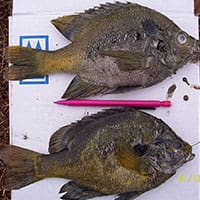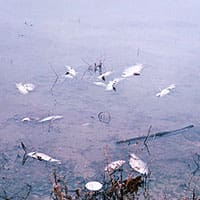
Common Causes of Fish Kills in Your Pond or Lake
The first question everyone has when they notice fish floating in open water or washed up along the bank is: what killed my fish?
The most common causes of fish kills are oxygen depletion, algal blooms (could deplete oxygen or be toxic), pesticide toxicity and disease. By far, the most common cause of fish kills is oxygen depletion in lakes or ponds.
There are two general types of fish kills due to lack of oxygen in your lake or pond: summer fish kills and winter fish kills. Sorry for the people up north, but we are not going to dig into winter fish kill. For our clients in Texas summer fish kill is worth understanding.
There are two types of summer fish kill related to lack of oxygen in your lake or pond. The first we will discuss is called pond or lake turnover. These pond or lake turnover summer kills are most common in early and late summer.

A few scientific principles will allow us to better understand the functions behind lake turnover fish kills. 1) Cool water holds more oxygen than warm water, and 2) cool water is denser than warm water.
During the summer, your pond or lake tends to stratify by temperature driven density differences with warm water on top and cool water at the bottom of your lake. Oxygen stratification is also very evident in the summer months. High oxygen concentrated water occupies the upper parts of a lake due to greater wave action and biological activity in this area. At lower depths, wave action has little affect, and biological activity is greatly reduced since the sun does not reach these depths.
So we have warm oxygen rich water on top and cool anoxic water on the bottom of your lake. Then a large rain event occurs and dumps a lot of cool rain into your lake. This cool rainwater is denser than the surface water, so it sinks to the bottom of the lake (remember the bottom of the lake is nearly void of oxygen). The new, cool rainwater displaces the anoxic water at the bottom of your lake. The displacement of anoxic water from the bottom of the lake essentially mixes throughout the entire lake, which lowers the oxygen levels of the entire lake. The sudden mixing of anoxic water is what kills your fish in a summer lake turnover. This sudden mixing can also be caused by strong persistent winds, which essentially breaks the natural thermal stratification and allows the anoxic water to be mixed throughout.
The second summer fish kill type is called the large oxygen swing fish kill. This type of summer fish kill has little to do with forced mixing of the oxygenated water with anoxic water.
The large oxygen swing fish kill always occurs in lakes with large amounts of submerged aquatic vegetation, floating algae or planktonic algae (pea soup water).
With large amounts of aquatic weeds and algae, a lot of CO2 is consumed during the day by photosynthesis. In turn, photosynthesis produces large amounts of oxygen, so much that the lake oxygen concentration becomes supersaturated with oxygen. Supersaturated oxygen concentrations means the water is holding more oxygen than it should at a given temperature. In general, the more supersaturated the oxygen concentration the more plant material present. Your fish don’t usually die from oxygen supersaturation, although they can. This condition is called gas bubble disease.
Where your fish begin to die in the large oxygen swing fish kill is when these aquatic weeds and algae switch from photosynthesis during the day to respiration at night. What happens is the plants that supersaturated the water with oxygen begin to consume oxygen and produce CO2, essentially supersaturating the water with CO2. Fish are not like plants; they cannot switch from breathing oxygen to breathing CO2. You usually find your dead fish in morning; with large oxygen swing fish kill. Both types of summer fish kills can largely be prevented by proper supplemental aeration.
The table below will help generally determine which type of fish kill you experienced.
| Benchmark | Oxygen Deficiency | Algae Bloom | Disease | Pesticide Toxicity |
| Fish Behavior | Swimming near surface gasping for air | Abnormal Swimming | Abnormal Swimming | Abnormal Swimming |
| Time of Fish Kill | Nighttime into morning | Brightest part of day | Anytime | During period of additional stress besides disease |
| Size of Dead Fish | Large fish die first | Small fish die first | Small fish die first | Any size |
| Microscopic Algae Abundance | Algae dying | One dominant algal species | No effect | Pesticides may kill algae, which may make fish kill look like oxygen deficiency type |
| Dissolved Oxygen Concentration | Less than 3 ppm oxygen | Supersaturated oxygen concentrations | No effect | Little effect |
| Fish Species Selectivity | Desirable game fish first, rough undesirable fish are usually more resilient to low oxygen levels | All fish species affected | Usually one fish species | One fish species dies before others |
| Water Color | Brown, gray or black | Dark green, brown, or golden | No effect | normal |
Tags:
Recent Posts
- Quick Guide for Pond & Lake Problems 11/28/2024
- Common Causes of Fish Kills in Your Pond or Lake 11/09/2024
- Basic Lake Construction Techniques, with a Focus on Clay Compaction 11/04/2024
- Water Snake Identification 11/04/2024
Categories
- Uncategorized (4)
